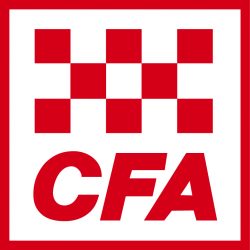When the act was implemented in 1945, the Country Fire Brigades Board and the Bush Fire Brigades Committee were superseded. Country fire brigades and bush fire brigades, hitherto completely separate entities, were now united in the one organisation as “urban” and “rural” fire brigades, respectively.
The Ferntree Gully Brigade retained its responsibility for the protection of its gazetted fire district. Our common boundary with Boronia Brigade, defined by the old Board as early as August 1942, ran in an easterly direction along Blind Creek from Scoresby Road to the railway line, thence via Hutton Avenue, Forest Road and Mountain (now 01ivebank) Road to the perimeter of the National Park. Fearful, perhaps, that we might have had designs upon each other’s territory, the then Secretary of the Board stated emphatically that “it is hardly necessary to explain that the Ferntree Gully Brigade will have the area to the south of the above boundary, and the Boronia Brigade the area north of it.
In 1946, the Country Fire Authority replaced the Chevrolet appliance, issued to the Brigade in 1942, with a Ford front-mounted pumper. This vehicle would remain in service with the Brigade for ten years.
The Brigade’s purchase that same year of two “walkie-talkie” radios marked a technological advance and an emerging acceptance of the advantages to be offered by a rapid communications system. Mainly the men returning from active war service fostered this interest, for they readily appreciated the scope and application of the radio to fire service operations.
The radio equipment comprised heavy, cumbersome and ungainly war surplus transceivers, which necessitated constant tuning and were generally quite cantankerous in their operation. When working on bush tracks or, indeed, when reversing into fire stations, particular care had to be exercised to prevent damage to the whip aerial. And the perennial debate over the comparative virtues of base, and centre-mounted loading coils, has yet to be resolved.
However, the challenges created by such difficulties were met and over come by our communications pioneers who developed a sound and practical system, which has constantly proved its worth.
It was during these years, too, that the Brigade members developed an interest in competition work, and fielded teams at fire brigade demonstrations in Gippsland and on the Peninsula. Training tracks were laid out in The Glen, and in Dawson Street in Upper Gully.
Further moves were now afoot, this time quite literally, to secure a permanent home for the Brigade, and in 1950 the Country Fire Authority purchased the present site in The Avenue, to which the establishment was moved lock, stock and hose trough.
